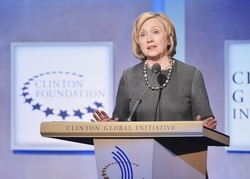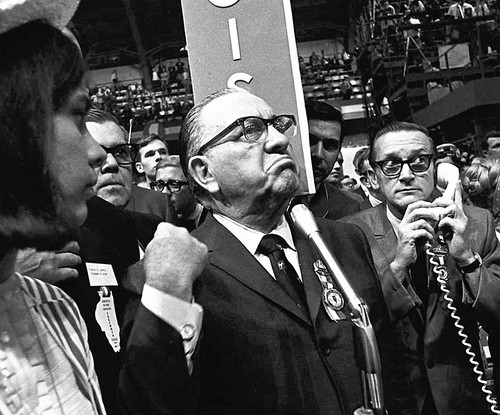|
Political patronage in the current era looks nothing like the patronage of old. Back then, in Daley’s Chicago or Tammany New York, jobs, precinct work and votes were bound into a tidy package. Working the street for the political boss connected residents to the political goals and aspirations of a tightly wired machine and, to an extent, vice versa. Whipping voter turnout connected precinct workers with jobs - for yourself, your family, maybe others with whom you were related. The elite jobs in this world included decent paying positions in government bureaucracies as determined by the Big Boss. Back then the overall goal of the machine was to take and hold power along with overseeing the distribution of benefits that power bestowed.
In bygone times, underbosses fed the bread and butter of patronage and the resulting quid pro quo of interests. In a first meeting with underboss (Ward Committeeman) Marshal Korshak in Daley’s Chicago his one and only question of the group I was a part of: What do you want? He’d already calculated for himself what, if anything, he stood to gain by delivering. In our time patronage has evolved into what I am calling the “new patronage”. To be sure some of the current attachments tie bureaucratic aspirants or even Cabinet level aspirants to a political nexus but more significantly the new patronage ripples out into vast, high powered consultancies, linked foundations and non-profits, media ventures, businesses of all kinds gunning for a profitable score, tech wizards, even foreign governments and big players in foreign countries. In our time the Mayor Daley’s and Tammany Halls still reign in select outposts but where it survives it is layered over by and partially submerged in the new patronage. Clinton Incorporated and Koch Incorporated typify the new patronage. The transactional currency of the new, like the old, is power along with the financial benefits that power both commands and bestows. The linkages, however, are far more wide ranging and consequential. Sussing out the networks - performing a power analysis in IAF terms - is rewarding because otherwise what happens in politics is incomprehensible. An examination of Clinton Incorporated, Koch Incorporated offers insight into those and other competing patronage networks attached to other bosses. These frame the battles, large and small, that without major organized citizen intervention define the future of public life. At issue is not trumped up, episodic, mediagenic protests (Dick Harmon calls them “selfie” protests) that hide more than they reveal, but the hard skeleton of self interested political struggles. The emergence of new patronage networks also helps render intelligible the bitter fruit of Donald Trump’s campaign for president fueled largely by a population of individuals and families institutionally sidelined by both political parties and largely abandoned by the community institutions that once formed and framed their associations, prospects and actions. In the patronage world of old, barriers to entry were semi permeable. An enterprising individual could literally work his/her way up into the cogs of the operation. The education level of foot soldiers was irrelevant to advancement. Mostly working class, producers could move up in the organization if they delivered. The new patronage is rigidly exclusive with money the primary leverage for access. (Hillary Clinton spent a precious campaign month encountering the rich and famous in the Hamptons rather than talking with voters where ordinary people gather. She walked away with a fistful of dollars and guests garnered a fistful of IOU’s.) The new patronage army is staffed by highly educated individuals with relevant skills. Their worldview is shaped by the twin drivers of wealth and refined skill sets. Feedback in the new patronage is determined not by what takes place in the streets, neighborhoods, schools, churches or lodges but through paid polling gurus and hired policy experts, themselves constitutive of the new patronage networks. One consequence of the shift is that valuation of local knowledge with accompanying innovative, inclusive potential is severely circumscribed if not altogether locked out. The conspicuous lack of strategic innovation and public mission reflected in the campaigns of both parties is partly a result of the new patronage which eschews the insights, prospects, hopes and fears that emerge from the street, neighborhood and community based institution. In its place comes pre masticated agenda building grounded in the swirling new patronage networks that mash up a jumble of narrowly competitive, self referential policy objectives. Conspicuous among these objectives is relentless attention to securing and maintaining positional advantage in the new patronage infrastructures themselves. The new media might seem at odds with the new patronage by virtue of its potential inclusiveness (a blog in every household, friends in every feed, YouTube at every gathering). In fact, the reverse is true. The new patronage armies rapidly reckon with the purchase and distribution of content along lines ginned up by colleagues serving other functions in the network. Illusional or even delusional claims become the self referential orders of the day. The propensity for the new patronage to patronize the outs is unlimited. The ins know the game, everyone else is a sucker. Like working the polls on your own time in the old days. The kiss and tell stories common to the new patronage - uncommon in the old - simply underscore the transactional nature of relationships in question. Dick Morris was a Clinton operative until his prospects dimmed in contrast with the more promising network to which he aligned his interests. Now he calls the November 2016 presidential election: Armageddon. The media is rife with kissers and tellers because they make a good if short lived story. Commonalities in new patronage networks do not extend to who and what sources them. The Koch Bros Inc reside at the top of a business based empire with hundreds of billions at their disposal. What they are doing likely matters more in the long run than presidential electoral polytechnics. Clinton Inc has meticulously built up a sprawling network of contacts turned into acolytes, experts and funders over the course of three decades in public “service”. That the Clinton’s have become rich in recent years (though not in comparison to the Kochs) their patronage network derives primarily from the complex interweaving of public and private jobs over which they exercise control. The co-mingling of public and private ventures - policy deals, access, hires, endorsements and the like - isn’t a by product of Clinton Inc rather it is the core of the new patronage itself. The long term implications of the new patronage are only beginning to work themselves out. Three are already clear: Both major political parties are battered hulks staggering under internal and external assault; bright young aspirants to public life find an easier leg up through new patronage networks than traditional party means; “movements” for change nest easily within the new patronage embrace as their media pyrotechnics gain momentary attention. What’s required to counter the new patronage is a sharpened contrast between what’s real and substantive public business vs. narrowly self serving new patronage reinforcements that accelerate the disfunction. Discerning the difference between real, constructive, hard fought publicly articulated deals as against spasmodic, narrowly self interested posturing played to this or that inflamed audience is vitally important. This becomes the responsibility of all serious institutional protagonists advocating the common good in the public life of the nation . Positive examples are scattered throughout the United States and, for that matter, the world. You have to look no farther than the gridlock breaking body blow delivered to Congress in the fight for Louisiana flood recovery dollars. Or the breakthrough mega deal struck by organized citizens in Baltimore with a major developer that leveraged $100 + million of community benefits. These case studies, with Together Louisiana/IAF in one and BUILD/IAF in the other, are associated with the oldest and largest “community organizing” network - The Industrial Areas Foundation. It’s no coincidence that IAF organizations have resisted the temptation to recline in the embrace of far flung new patronage networks often defining themselves over against them. Nor is it coincidence that the new patronage networks in response generally detest (though grudgingly admire) the organizational heirs to Saul Alinsky’s renegade brand of non-partisan political action. Building on insights drawn from places like Baltimore and Baton Rouge the way forward appears to open up not in alliance with the voracious appetites of the new patronage networks but in deep exploration of the local ventures constructed on the rock solid ground of hard nosed leadership training, power analysis, relational methodologies, and locally owned institution building.
0 Comments
Leave a Reply. |
Frank C. Pierson, Jr.Frank Pierson retired after forty years of work with the Industrial Areas Foundation (IAF) as a professional organizer. He began his career in 1971 in Chicago, moved to Queens, New York City and migrated west to work in Arizona, New Mexico, Nevada and Colorado. He resides with his wife, Mary Ellen Kazda, in Oracle, Arizona. He may be reached at [email protected] Archives
June 2018
|





 RSS Feed
RSS Feed
